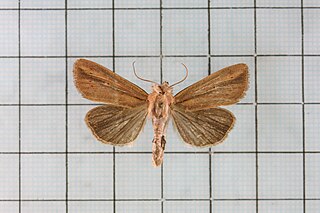
The genus Crambus includes around 155 species of moths in the family Crambidae, distributed globally. The adult stages are called crambid snout moths, while the larvae of Crambus and the related genus Herpetogramma are the sod webworms, which can damage grasses.

Mythimna pallidicosta is a moth in the family Noctuidae first described by George Hampson in 1894. It is found from north-eastern India to western China, Sri Lanka, Taiwan, Sundaland, Flores, the Philippines and Japan.
Trichromia phaeocrota is a moth in the family Erebidae. It is found in French Guiana and Venezuela.
Charltoniada apicella is a moth in the family Crambidae. It was described by George Hampson in 1896. It is found in India and Sri Lanka.
Haimbachia strigulalis is a moth in the family Crambidae. It was described by George Hampson in 1896. It is found in India, Sri Lanka and China.
Achyra nigrirenalis is a moth in the family Crambidae. It was described by George Hampson in 1913. It is found in Australia, where it has been recorded from Western Australia, the Northern Territory, Queensland and South Australia.
Anania perflavalis is a moth in the family Crambidae. It was described by George Hampson in 1913. It is found in Australia, where it has been recorded from Queensland and New South Wales.
Patissa fractilinealis is a moth in the family Crambidae. It was described by George Hampson in 1919. It is found in Kenya and Uganda.
Cynaeda albidalis is a moth in the family Crambidae. It was described by George Hampson in 1913. It is found in Iraq.
Archernis albicostalis is a moth in the family Crambidae. It was described by George Hampson in 1913. It is found on Borneo.
Polygrammodes citrinalis is a moth in the family Crambidae. It was described by George Hampson in 1913. It is found in Papua New Guinea.
Polygrammodes semirufa is a moth in the family Crambidae. It was described by George Hampson in 1913. It is found in São Paulo, Brazil.
Proleucinodes melanoleuca is a moth in the family Crambidae. It was described by George Hampson in 1913. It is found in Peru.
Udea diopsalis is a moth in the family Crambidae. It was described by George Hampson in 1913. It is found in Chile.
Udea melanephra is a moth in the family Crambidae. It was described by George Hampson in 1913. It is found in Colombia and Bolivia.
Udea nomophilodes is a moth in the family Crambidae. It was described by George Hampson in 1913. It is found in Chile.
Udea ochropera is a moth in the family Crambidae. It was described by George Hampson in 1913. It is found in Colombia and Mexico.
Udea secticostalis is a moth in the family Crambidae. It was described by George Hampson in 1913. It is found in Paraguay and Argentina.
Udeoides muscosalis is a moth in the family Crambidae. It was described by George Hampson in 1913. It is found in Kenya and South Africa.
Udeoides nigribasalis is a moth in the family Crambidae. It was described by George Hampson in 1913. It is found in Kenya.

